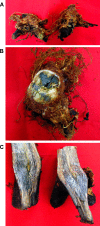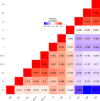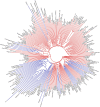Association mapping of quantitative resistance to charcoal root rot in mulberry germplasm
- PMID: 29979732
- PMCID: PMC6034859
- DOI: 10.1371/journal.pone.0200099
Association mapping of quantitative resistance to charcoal root rot in mulberry germplasm
Abstract
Outbreaks of root rot disease in the productive South Indian sericulture belt have threatened the sustainability of the industry. Macrophomina phaseolina (Tassi) Goid. causing charcoal rot is the predominant pathogen to which all productive mulberry cultivars are susceptible. The present study was undertaken to identify molecular markers associated with charcoal rot resistance in mulberry. A mapping panel comprising 214 diverse entries from the Indian germplasm collection was assessed for charcoal rot resistance by artificial inoculation. Resistance to the pathogen was observed in 20 entries, and 51 were found to be moderately resistant. A total of 773 alleles generated across 105 SSR loci and 20,384 AFLP markers generated using 32 EcoRI-NN and MseI-CNN primer combinations were used in genetic analysis. The panel was weakly structured with two subpopulations. However, most entries were found to be admixtures. Survival of cuttings and number of roots per sapling were associated with root rot resistance. Association mapping was performed using different linear mixed models. Five AFLP markers explaining 9.6-12.7% of the total phenotypic variance were found to be significantly (p < 0.05) associated with root rot resistance. Significant associations were also detected in four AFLP markers for survival of cuttings, and these markers explained 10.7-14.2% of the total phenotypic variance. These markers should be validated using mapping populations derived from contrasting biparental combinations by linkage analysis for use in marker-assisted gene pyramiding for durable resistance. The resistant genotypes identified in this study will substantially contribute to genetic improvement of mulberry for charcoal rot resistance and can be integrated into conventional breeding programmes.
Conflict of interest statement
The authors have declared that no competing interests exist.
Figures









References
-
- Yanagawa H, editor. Frequently asked questions in bivoltine sericulture technology: mulberry cultivation technology. Mysuru: Japan International Cooperation Agency; 2003. p. 16.
-
- Meyer WA, Sinclair JB, Khare MN. Biology of Macrophomina phaseoli in soil studied with selective media. Phytopathology. 1973;63: 613–620.
-
- Short GE, Wyllie TD, Bristow PR. Survival of Macrophomina phaseolina in soil and in residue of soybean. Phytopathology. 1980;7: 13–17.
-
- Sowmya P. Molecular characterization and diversity analysis of fungi causing root rot disease in mulberry (Morus spp.). Ph.D. Thesis, The University of Mysore. 2018.
-
- Central Silk Board. Annual report 2016–17. Bengaluru: Central Silk Board; 2017. p. 100.
Publication types
MeSH terms
Substances
LinkOut - more resources
Full Text Sources
Other Literature Sources

